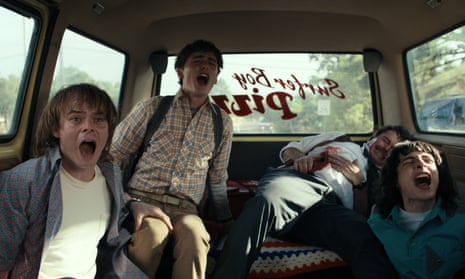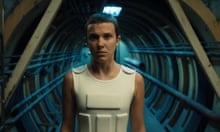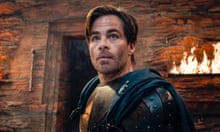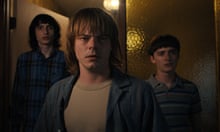The press release accompanying volume four of Stranger Things makes a reckless boast: “Over five hours longer than any previous season!” The show is among Netflix’s biggest hits, but it returns at a time when the streaming platform’s business model – hook subscribers by hurling cash at bloated mega-shows, while deferring making any profit for as long as possible – is starting to creak. It feels rather provocative to trumpet that a knockabout sci-fi caper that was already in danger of treading water in its second and third seasons has been “supersized” – in other words, even vaster sums of money have disappeared into it.
Yet the gamble pays off. If large budgets are to be indulged, one wants to see them clearly on the screen, and that’s immediately the case as we cruise back into Hawkins, the small Indiana town perched on a portal to a monster-infested netherworld, in 1986. Simple scenes such as kids arriving at high school or visiting a roller disco have a new scope, with scores of impeccably retro-shod extras and just the right vintage cars or Formica fittings. The beautiful strip-mall shop fronts, a giant labour of love for some lucky set designer, deserve their own Instagram account. There are more characters and more locations (Nevada, California, Alaska, Russia) as the ensemble is split up and scattered, giving ST4 enough strands to sustain episodes that routinely stray beyond an hour each. Everything is unapologetically bigger.
More important, Stranger Things now has a supersized dramatic purpose, on the assumption that the 12-year-old viewers who were wowed by season 1 are now 18 and ready for darker meat. What was once a spooky but essentially cute thriller, in hock to Steven Spielberg, has taken on elements of full-blown horror inspired by The Exorcist and A Nightmare on Elm Street. Limbs snap. Eyes are gouged. Unlike the old monsters who would spend most of the season unseen, rattling windows and making lights flicker, this year’s impressively realised fiend – a hideous humanoid with no nose, claws for hands and a house in the benighted realm that could really benefit from significant modernisation – is in full horrific effect from the get-go.

The coming of age of Stranger Things does not stop at the gruesome special effects, either. The opening minutes include a reflection on how Hawkins is a community damaged by tragedy – specifically a reference to the end of the third season, when several people died in an explosive three-way battle between rogue Russian agents, a creature called the “Mind Flayer” and a gang of resourceful children. But in a show returning after a pandemic-induced delay, the contemporary resonance is unmistakable.
Surprisingly, the show follows through on this idea, matching the narrative’s distressing visuals with a psychological depth that has previously been absent. The supernatural being preys on the kids’ worst memories, turning the main story into one about childhoods torn up by trauma. It can even be read as an allegory for teen suicide: episode four, the standout from the seven new ones and perhaps the show’s best single instalment ever, makes heartwrenching use of a montage of fun moments from episodes past, illustrating what would be lost if any of these goofy kids were overcome by their demons.
So what of the kids themselves? Where once they worried about who fancied whom, now they are experiencing proper dating issues such as fear of commitment and the awkwardness of long-distance relationships. If on occasion these more adult themes are too much for the cast to cope with, the show’s new structure, hopping gaily between four or five parallel stories, rides over the odd rough patch.

There are some casualties of the sprawling narrative: police chief Jim Hopper (David Harbour) is marooned in a Russian prison in a dead subplot that sucks scatty mom Joyce (Winona Ryder) and angry nerd Murray (Brett Gelman) into its black hole of cuttable material. The breakout star of season 3, Priah Ferguson as little sister Erica, is hardly in it, and the best new character – Joseph Quinn as long-haired Dungeons & Dragons freak Eddie Munson, a rock god who is less Hawkins, Indiana and more Justin Hawkins from the Darkness – blazes brightly for one episode before being chewed up in the gears of the plot.
But with CB-radio-wielding oddball Dustin (Gaten Matarazzo) still hacking computers, riffling through cassette tapes and forming half of the best odd-couple comedy duo on telly with Joe Keery as fallen high-school idol Steve, plenty of the old magic persists. Stranger Things is bigger, older, somewhat sadder – and as lovable as ever.









Comments (…)
Sign in or create your Guardian account to join the discussion